|


By Julie Martin Mangis
|
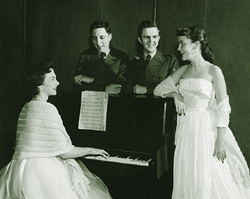
GW Troubadours visited Thule AFB in Greenland during a holiday season tour of Northeast Air Command installations. Singers Jolene Oakes (pianist) and Pat Reed found two D.C.-area military men to serenede: from left, A/1C John D. Sadler and A/2C Carl Davis.
|
The dreary December weather outside could not match the dismal atmosphere in the children’s ward at The George Washington University Hospital that morning in 1965, or for that matter, practically any morning. Here is where some of the sickest children were cared for, the ones with the heart defects and other congenital disorders. Some lived in this tiny ward for months at a time, receiving only occasional visits from their families. Others were recovering from surgery. Most were in incubators, devices that isolated them from sounds, smells, and sights, and most heartbreaking of all, touch. These babies were rarely cuddled.
On this particular morning, one of the patients was a toddler recuperating from cleft palate surgery. His hands were tied down so he could not thrust his hand into his mouth and disturb the delicate stitches. His mother lingered nearby but she, too, was restrained because the incubator’s walls separated them. Hugging her son was out of the question for the time being.
Suddenly the door opened and a tall craggy-faced man, dressed in his doctor’s scrubs, entered. As he conducted a quick medical examination of his small patient, he began singing. The mood instantly lifted as the strains of Brahms’ Lullaby penetrated the gloom. The doctor’s rich bass-baritone voice blended with the mother’s soprano and all the children in the ward were immediately transformed… from gaunt and lethargic to smiling and animated. It was as if they had suddenly been embraced. In a place where touch was nearly forbidden, music proved to be the only message that could penetrate their lonesomeness. Music was the perfect medicine.
Such a scene was typical of Robert Howe Harmon, MD ’29, obstetrician-gynecologist-pediatrician and member of the medical faculty as well as University Physician; director of GW’s Men’s and Women’s Glee Clubs in addition to several other Washington choruses and musical organizations; pole vaulter and member of GW’s Athletic Hall of Fame. He spent 40 years directing the University’s choral groups, taking them on performance trips around the world and establishing a University reputation for choral singing that continues even today.
|
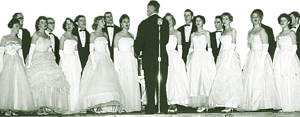
Dr. Harmon conducts the GW “Traveling Troubadours” at a Christmas 1960 performance at Argentia Naval Base, Newfoundland.
|
Described by his chorus members as larger than life, energetic, dedicated, affectionate, inspiring, and charismatic, Doc was always singing, it seemed. It is said that when he visited his bank, his singing could be heard by the tellers inside as soon as he emerged from his car in the parking lot. According to the Riggs’ branch manager, it was a highlight of the day when Harmon entered the back door singing an operatic aria with a big smile on his face.
|
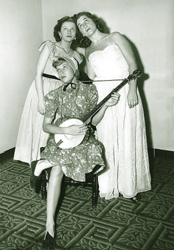
Three members of the Glee Club in performance in 1951: Shown are Mary Slotemaker (seated) and Joanne Winslow (left) and Virginia Perrott (standing).
|
An imposing figure more than six feet tall, handsome, and physically-fit, Robert Howe Harmon was born in Bay Saint Louis, Miss., on Oct. 5, 1894. The son of a Methodist minister, he completed his undergraduate degree at Millsaps College, where he held the Southern Conference record for pole vaulting. Harmon became a schoolteacher after graduation, and married Grace Ruble, also a teacher. The two moved to suburban Maryland, where he taught and later served as principal of Rockville High School.
Early in their marriage, the Harmons suffered the loss of two daughters, one as an infant and the second one at the age of two. Convinced that better medical care could have saved the two children, Harmon made up his mind to enter GW’s medical school and to specialize in obstetrics and pediatrics. He attended medical school at night while teaching and coaching at Columbia Junior High School, competing on GW’s track team as a pole vaulter, and singing with the Men’s Glee Club. By 1923, he was assistant director, and in 1925, he became director of the Glee Club. He still had several more years before he would complete his MD in 1929.
Almost as soon as Harmon assumed the directorship, the Men’s Glee Club began to develop a first-class reputation and to gain recognition both at GW and in the community. Performances at the Rialto, Keith’s, the Earle, and Poli’s Theaters received coverage in local newspapers. There were benefits and public appearances at special events, even White House invitations. In the spring of 1929, the Men’s Glee Club was performing with the Columbia University Glee Club in a joint recital when they learned of the Intercollegiate Glee Club Contest held annually at Carnegie Hall in New York City. They were eager to participate.
|
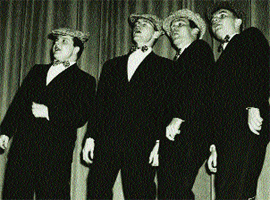
A Colonial Quartet, singing during an overseas trip in April 1950. From left: Richard Hedges, Stephen Anderson, John Parker and Wade Currier.
|
“It took a little doing,” explains Winfield Weitzel, BS ’58, who was a member of the Men’s Glee Club at the time. “Because we had to win a regional competition to be invited to New York, we had to first form the local Mid-Atlantic Glee Club Association with the choral groups from Johns Hopkins and Catholic Universities. Then, we had to sponsor and win a competition among the three local clubs.”
The group succeeded and, within a year, the GW Men’s Glee Club was on its way to New York to compete in the prestigious contest. Most of the other invited groups had Ivy League choral traditions and had been competing for years. Furthermore, unbeknownst to the GW men who arrived with rented black dinner jackets, the proper dress for the event turned out to be white tie and tails. Spirits were not daunted for long, however, as the unflappable Doc nudged the singers to perform their best, reminding them that their music was what counted.
The 1930 GW Men’s Glee Club left the stage that evening with the championship trophy, having won handily over Yale, Dartmouth, Harvard, Princeton, and others. It was clearly a night of triumph.
|
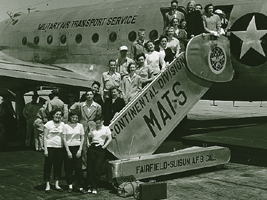
The GW Glee Club prepares to depart from California, embarking on a three-week, 26,000-mile tour of Pacific bases in June 1950.
|
The Glee Club returned to the contest in 1931 and placed third. By this time, Doc also was directing the Women’s Glee Club, and Grace Ruble Harmon was serving as accompanist and assistant conductor to both groups. The two would eventually become surrogate father and mother to hundreds of GW students. In the words of Sue Farquharson Law, BA ’52, “They loved young people and derived strength from them; they also loved singing and derived joy from it.”
“They set an example of optimism and joy, of coolness under pressure, of striving for excellence in both singing and character,” wrote David M. Bates, BA ’46, in Forty Years of Harmony, a monograph about the Harmons. “When Doc had to miss a rehearsal occasionally because of his medical practice, she [Mrs. Harmon] filled in for him. She brought her own calm intensity to her direction, and made her own firm, pointed demands for good singing in a very mature manner… The student singers loved her as much as they did Dr. Harmon…”
|
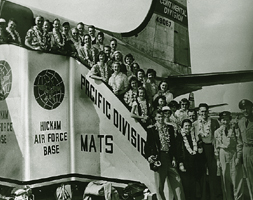
A stop on the June 1950 26,000-mile tour was Hickam Field, Hawaii.
|
The Glee Clubs sang for numerous area organizations during the 1930s and appeared in five concerts with the National Symphony Orchestra. The symphony’s conductor, Hans Kindler, offered a supreme compliment when he said that Harmon was “born with music in his soul.” Kindler also gave Doc his first opportunity to conduct a major orchestra, when he passed the baton one afternoon in a rehearsal.
During the war years, the GW campus had very few male students. At one Messiah rehearsal, Bates recalls that only three men were present while there was a full complement of women singers. Yet the Glee Clubs carried on with the help of occasional alumni “ringers.” Concerts were often involved with the war effort. The students performed at bond rallies and entertained troops at hospitals, USO Clubs, and the Stage Door Canteen. One of the performers was President Truman’s daughter Margaret, BA ’46, who became a soprano soloist in the Women’s Glee Club.
Often, Child’s Restaurant at New York Avenue and 14th Street served as a focal point for celebrations after Glee Club concerts. “Doc” loved to take his choristers there, order waffles and pancakes, and then treat the restaurant patrons to an impromptu concert. Invariably, he directed in his stocking feet while standing on a table strategically placed where his merry band of singers could see him. The late-night diners were usually an appreciative audience.
|
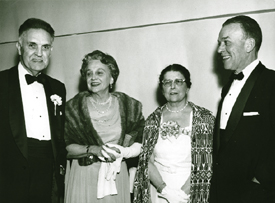
A scene from the Harmon Testimonial Dinner, held in Washington May 16, 1959: Dr. Oswald S. Colclough, acting president of the University (far right), joined in celebrating with (from left) Dr. Harmon, Mrs. Colclough, and Mrs. Harmon.
|
By the end of the decade, men arrived back on campus in great numbers, helped by the G.I. Bill. The Men’s and Women’s Glee Clubs were combined into one organization, and selectivity entered the choral program, with auditions and required rehearsal attendance. In addition, Harmon, assisted by Professor Vincent J. DeAngelis, BS ’39, MA ’48, began laying plans for a traveling choral group that would carry the name of The George Washington University to distant corners of the world.
The GW Traveling Troubadours, as they came to be known, took their first Air Force-sponsored trip to Newfoundland, Labrador, and Greenland in April 1950. The group, it was reported, included the first American women to set foot on Greenland ice. During the summer of 1950, the Troubadours toured Pacific bases, including Hawaii, the Marshall Islands, Guam, Okinawa, the Philippines, and Tokyo. Christmas found them in Alaska. In the air over the Arctic Circle, the Colonials barbershop quartet became the first ever to broadcast from a location so close to the North Pole. The next several years saw them travel more than 100,000 miles, visiting bases on five continents including many repeat trips to the frigid north, always under the watchful eyes of the Harmons.
At Thule, Greenland, in 1954, the Troubadours appeared in the same show with Bob Hope. The comedian complained about the sweetness and naturalness of the GW women. “Toughest competition I ever had,” quipped Hope. It did not hurt that the Troubadours delivered one of their best performances that Christmas Eve.
|
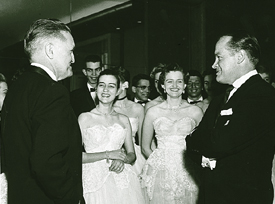
Bob Hope (right) joined Dr. Harmon and the GW Glee Club to entertain at the U.S.O. National Council dinner on March 5, 1958. The lucky young women in the foreground are (from left) Alice Turner and Angela Gnotta.
|
Meanwhile, the larger Glee Club continued its regular performance schedule: Handel’s Messiah during the Christmas season, Cherry Blossom Festivals, and Watergate concerts with the Air Force Symphony and Singing Sergeants. Rehearsals for both the Glee Club and the Troubadours took place throughout the academic year and the Harmons were always there. The groups also made recordings and radio broadcasts.
In 1956, a quintet of Troubadours received an invitation to perform for five weeks at the Shoreham Hotel. They proved to be so popular that they were extended to a total of 13 weeks. “I made enough money off that appearance to pay my tuition for the entire semester,” adds John Parker, BS ’50. And, in 1960, they had a six-week engagement at Radio City Music Hall, which also was extended. Again, the group exhibited superb professionalism, performing three shows a day.
What was an exhausting pace for the young people could only have been grueling for the Harmons who were, by now, in their sixties. Yet, they never missed a performance and they always remained upbeat and positive.
“Doc” was always “on call,” delivering more than 3,000 babies—sometimes leaving rehearsals to do so. It is said that he never lost a mother or a baby in his medical practice. His nurses called him one of the happiest doctors they ever knew. For many years he served as University Physician, treating GW students in the years before more comprehensive University health services were offered.
As if his associations with GW, both medical and musical, were not enough, “Doc” was enormously active in singing groups throughout Washington. He was a charter member of the local chapter of the Society for the Preservation and Encouragement of Barbershop Quartet Singing in America, among many other groups.
Harmon was well known and respected throughout Washington, a fact that helped him obtain singing engagements for the Glee Clubs and solidify their reputation. He served as president of GW’s General Alumni Association and received the GW Alumni Achievement Award in 1949. In 1955, the GW Medical Society presented him with its Annual Award of Merit, in recognition of scientific accomplishment, academic attainment, and service to the community. In 1959, a testimonial banquet, organized by Richard Randall, BA ’49, MA ’50, was held in his honor with 300 guests in attendance. A speaker at the banquet remarked that “wherever you go in Washington —a ball game, a concert, a maternity ward, or a church—you’re bound to run into somebody who knows ‘Doc.’”
|
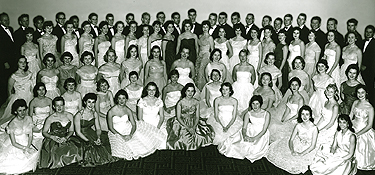
The 1959 GW Glee Club. (courtesy of “The Cherry Tree”)
|
While his formal training was not in music, Harmon had an extensive knowledge of musical works. The repertoire of the singing groups he directed was wide-ranging, from classical to Broadway shows, from liturgical music to spirituals. He also was a master of literature and was able to recite from memory passages from Robert Service poetry, Shakespeare, the Bible, and other master works. His grasp of history was acute, and he had a remarkable sense of humor. Most of all, he was a superb showman, with an instinct for making the connection to the audience that would make them holler for more.
On that bleak December day 36 years ago, even the babies in that dreary ward were able to sense “Doc” Harmon’s remarkable charisma and showmanship. Music was his language as he made that magic connection with them through plastic walls. They warmed to him instinctively, just like his many students and audiences over the years. The scene is one that this anxious mother will never forget.
Julie Martin Mangis, BA’84, sang in the Glee Club and Troubadours from 1960 to 1963. Her two sons were delivered by Harmon. Her son Jeffrey is the patient who was recovering from cleft palate surgery in December 1965. Mangis was also a student in one of Professor George Steiner’s first music appreciation classes. She served as president of the Harmon Choral Associates, 1994-98, and has been a member of its board since it was organized.

A New Chapter Begins
“We are so lucky to be involved in the arts because we are able to congregate together and create beauty,” exclaims Matthew W. Mehaffey at his first rehearsal with the University Singers. “Our only responsibility is to find the art—the meaning—and to do well, to connect in a human way with the rest of the ensemble.”
Mehaffey, GW’s newest director of choral activities, assumed his position in July 2001. He has strong and highly refined ideas for the choral program and is determined to move the program up to the next notch. His master’s degree is from Westminster Choir College, the premier choral program in the nation, and he recently completed his doctorate in choral conducting and historical musicology at the University of Arizona. He brings a wealth of choral experience to his position, having sung with the National Honors Men’s Choir, and with such world-class singers as Renée Fleming, Bryn Terfel, Samuel Ramey, Anne Sofie von Otter, and Sylvia McNair.
Mehaffey is eager to build upon the solid foundations established by choral directors Harmon and Pickar, and he brings energy and enthusiasm for what he believes GW’s choral program can become. “The establishment of four annual Presidential Arts Scholarships dedicated solely to the choral program means that in four years, 16 singers will be under scholarship,” he explains, “offering a superb opportunity for expanding and enhancing choral activities.” Mehaffety already has established a new ensemble, the Chamber Choir, which consists of 20 to 24 select voices performing a variety of music, both a cappella and accompanied, modern and ancient. The Chamber Choir will eventually travel, like the Troubadours.
Mehaffey has increased participation in the University Singers to 94, with plans to cap it at 100. “Raising the enrollment in the Singers makes it possible for us to perform some of the larger choral works,” he says. “These students should be able to have one capstone experience each year, such as an opportunity to sing with the National Symphony or a similar orchestra.”
With the increased enrollment, however, the University Singers are already becoming too large for both their rehearsal space and their traditional performance space, the Western Presbyterian Church. One challenge is to find appropriate rehearsal and performance space. Another goal is to purchase robes as performance attire for the Singers.
Mehaffey has already begun to meet and work with the alumni of the choral program. “Their dedication is evident in the $100,000 Choral Endowment, their annual contributions to the Harmon Fund, and their loyal support of student concerts,” he notes. He also is excited to be working in a liberal arts environment where student singers are immersed in literature, history, sociology and other disciplines that enrich their understanding of the music they sing. He is eager to explore with his groups the reasons why composers wrote the music and help them unlock what is inside the music.
“It is not a glamour thing… how great we sound. We want to do well for the music. The reason we continue to do Mozart is because there’s something there,” he tells them.
Alumni and friends will have an opportunity to experience the University Singers, under Mehaffey’s direction, at the Spring Concert in April 2002. Please call the Music Department at (202)994-6245 for information.
—JMM

Birth of a Department
|
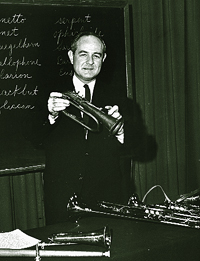
George Steiner
|
Prior to 1961, there were thoughts of establishing a Music Department at GW, but budgets were tight and the administration was not sure about the viability of a department. Ultimately, the success of an academic department depends upon the number of students it enrolls. But students will not enroll unless there are course offerings. The question was how to start.
A local musician and orchestra conductor, George Steiner, was appointed in 1961 and charged with founding a music program. Steiner faced numerous obstacles. One of his core courses was scheduled for three hours on a Friday night, never a popular time for students. Just acquiring a decent piano and getting it into the cramped space that had been assigned for music classes was a major feat. But Steiner persisted and the fledgling program flourished. Today GW’s Department of Music offers majors in a variety of musical fields, with modern facilities, an outstanding faculty, and hundreds of students.
From the beginning, Steiner knew that he had to have a faculty with music credentials in order to ensure accreditation of the program. To attract dedicated students, he believed it necessary to offer credit for participation in GW’s musical ensembles, with grades and required attendance. In its 40 years under Robert Harmon, the Glee Club had always been an extracurricular activity and Doc would not have kept a grade book. Furthermore, even though he was a renowned choral director, Doc did not have the appropriate music credentials to become a member of the music faculty. The result was that Harmon retired as director of the University Glee Clubs on Aug. 31, 1964, having served in that post for 31 years and having led GW musical organizations for a total of 40 years.
Three choral directors served GW between 1964 and 1979: Jule Zabawa, who also was a voice teacher; Dale W. Krider; and Stephen J. Prussing, who was music director at New York Avenue Presbyterian Church, professor of music theory, and a composer. Choral activity was limited to concerts on campus.
Catherine J. Pickar, MA ’80, began working with the Chamber Choir in 1979 while studying for a graduate degree in conducting. With her leadership, the Chamber Choir developed into a fine ensemble. She was selected by Steiner to serve as assistant conductor of his Alexandria Symphony and subsequently was appointed as a member of GW’s adjunct faculty to direct the Chamber Choir. She became the first woman to be appointed assistant professor of music in 1982, and she was named associate professor in 1998.
Pickar brought new life back into the choral program. She formed an a cappella singing ensemble of 12 to15 voices, and, after holding a competition to select a name, upheld tradition by calling the group The Troubadours. This group, like its predecessor namesake, also has traveled extensively, conducting performance tours both domestically and internationally. Pickar built the University Singers into a first-class ensemble, offering highly professional public performances at least twice a year. She helped organize the Harmon Choral Associates, an alumni organization that supports the choral program. And, she worked with the University to establish student performing arts scholarships dedicated to musicians, especially choral singers. Financial stability, ever elusive throughout GW’s choral history, has been attained largely through Pickar’s efforts.
Most notably, Pickar developed nurturing relationships with her students, not unlike the Harmons. Always willing to mentor, console, and assist, she helped many overcome adversity with her gracious touch and her warm humor. Those qualities were never more evident than this past April when Pickar was honored by alumni and students with an endowed seat in her name, part of the Choral Endowment that will return dividends to the program for years to come. A total of $18,500 was raised to ensure this permanent recognition for her service to the Music Department. It also marked another end to another chapter in GW’s choral history, for Pickar resigned in June 2001 to spend more time with her growing family.
—JMM
Back to top | Spring 2002 Table of Contents
|